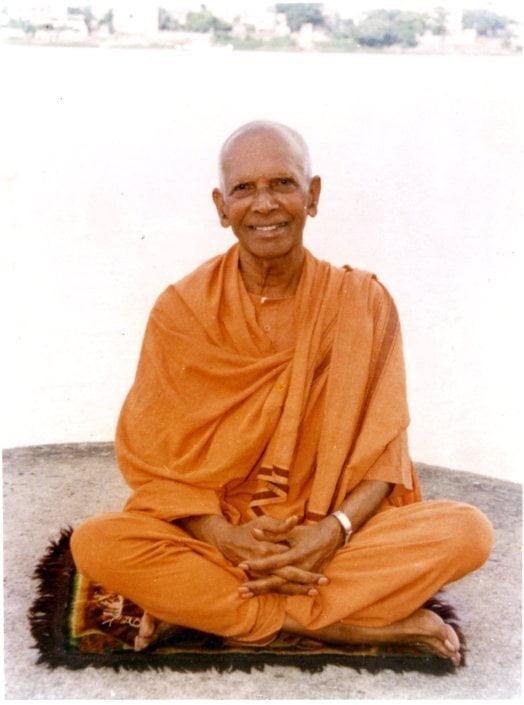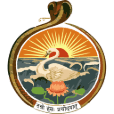
Birth and Early LifeSwami Ranganathananda was born on 15 December 1908 in Trikkur, a small village near Trissur in Kerala.
As a young boy, he once uttered some bad word, picked up at school, in front of his mother. She reprimanded him saying: “’ My boy, your tongue is the abode of Vani, or Saraswati, the goddess of knowledge and wisdom. Don’t soil it by using foul language against others.” These words penetrated deep into him. His speeches in later years testified to the fact that Saraswati was truly seated on his tongue.
Beginning of Monastic Life
As a young boy, he was always bubbling with energy. He later said: “Love of adventure and dislike for an easy life, and the German philosopher Nietzsche’s dictum ‘live dangerously’ has been with me ever since(childhood).” Even at a tender age, his keen and perceptive mind reacted to the virus of untouchability, then ubiquitous in Malabar. He made it a point to break caste distinctions. When he was about fourteen, Sri Ramakrishna entered his life through The Gospel of Sri Ramakrishna and he was never the same again. Religion now became palpable. The Complete Works of Swami Vivekananda, which he read subsequently, further revolutionized his mind and determined the future course of his life. The spiritual fire of his soaring young soul was stoked when he was initiated by his guru, who was then in a high spiritual state in Ootacamund. The initiation also testified to an earlier mystic dream the young boy had had about his guru. His young but mature soul naturally responded to the higher call of renunciation, service and God-realization, and in 1926 he joined the Ramakrishna Order in Mysore.
The first twelve years of Maharaj’s monastic life, spent at the Mysore and Bangalore ashramas, were days of hard work, study and meditation. He was involved in a host of Ashrama chores -from cooking and dishwashing to supervising the Ashrama hostel. He loved hard work. I have never known tiredness in my life, he would say later. Amidst the busy routine, he also found time to memorize the Gita and the Vivekachudamani. He would recall this whenever someone complained about being too burdened with work to make time for oneself.
Swami Ranganathananda’s phenomenal mental acumen and memory were a revelation to many- even scientists. His sharp intellect and tempered devotion set him apart from the ordinary.
He avidly and intensely studied not only Indian scriptures and mythology but also those of other religions. In his intellectual journey, he traversed through the minutiae of Eastern and Western philosophies, the various branches of science, history, sociology, psychology and economics- in fact, there was no field of knowledge that he did not touch. His intellectual appetite was so great that even ordinary subjects received his attention, not to speak of scientific discoveries and social trends, with which he kept himself abreast till the very end. The development of his brain was complemented with his athleticism. He exercised regularly and was agile and vigorous. Even in his seventies, Maharaj could be seen playing volleyball, leaping and smashing the ball like a young man. His missionary activity reflected a wonderful blend of ancient wisdom and modern science. He had commenced addressing the prisoners on ethical and spiritual life in Mysore Jail in 1933-34, and this he continued in Bangalore, among the youth, where he moved in 1935.
After Bangalore, Swami Rangnathananda was secretary and Librarian at Ramakrishna Mission, Rangoon, Burma, from 1939 to 1942. When Rangoon had to be evacuated in the face of an impending Japanese invasion, he chose to return to India on foot along with thousands of other refugees, braving untold dangers but yet helping many on the way. During 1942-48 he headed the Mission’s Karachi centre. His lectures there were very popular and were attended by all sections of society. Following the closure of the centre in the wake of the Partition, he was sent to head the Ramakrishna Mission in New Delhi between 1949 and 1962. This period turned out to be the most fruitful in the centre’s history. Apart from helping the victims of the Partition who were temporarily sheltered near Delhi, Maharaj built a temple, a students’ library and an auditorium that used to be packed with the city’s elite during his lectures. During 1962-67 he was in Calcutta as Secretary of the Ramakrishna Mission Institute of Culture and Director of it’s School of Humanistic and Cultural Studies. His lecture in the city became very well known among the intelligentsia. Then, for twenty years to 1993, Maharaja was President of Ramakrishna Math, Hyderabad, where he founded an ashrama on land provided by the Andhra Pradesh government. There he undertook various rural development programmes and stirred the people of the city with his brilliant and profound discourses on Vedanta.
At the government’s urging, Maharaj gave yearly talks to trainees at the National Academy of Administration, first at Delhi in 1956 and after that at Mussoorie, for many years. He also regularly addressed cadets at the National Defence College, Delhi. Generations of administrators and bright minds destined to lead the country heard his wonderful expositions on Indian values and how they could be implemented in the administrative field. He served as a member of the Indian National Commission for cooperation with UNESCO during 1964-67. Between 1956 and 1972 he went on several world tour as an ambassador of religion and Indian culture, travelling to over fifty countries in North and South America, Asia, Africa and Europe, including the then Communist states of USSR, Poland and Czechoslovakia. During these government-sponsored tours, he lectured regularly, tirelessly and brilliantly. Universities, colleges, schools, cultural institutions, clubs and small groups of interested people all receiving something solid from him. From 1973 to 1986 Maharaj undertook annual tours to the US, Europe and Australia spreading the message of Vedanta and Ramakrishna-Vivekananda. Never confined within the limits of race, language or nation, his consciousness was always international and universal. So his audiences, be they learned or ordinary, young or old, immediately connected with him. He loved and dared-to discuss the challenging contemporary problem in the light of eternal values and Vedantic concepts and drew appreciation from one and all from savant to servants. His national tours, which took him to all kinds of institutions were as demanding as they were enlightening. He was proficient in several languages and was instrumental in starting many new Ramakrishna Math and Ramakrishna Mission centres-. He also helped and inspired other organizations and individuals to start ashrama where swami Vivekananda’s practical Vedanta could be practised.
Following the policy that Swami Vivekananda laid down for the Order, Swami Ranganathananda always remained apolitical; yet statesmen and politicians of all creeds and affiliations, including rebels, came to him for sage advice. He worked for national integration at all levels, bringing politicians and administrators, industrialists and technocrats, educationists and students, scientists and professionals, doctors and lawyer, businessman and workers, and even children to believe in their country, to stop the exploitation of every kind, and to work for the amelioration of the poor and the downtrodden. Maharaj never kept any money with him; whatever money came to him was spent on charitable and social service schemes that helped humanity, either through the branch centres of the Ramakrishna Mission or other philanthropic organizations. For all his towering public stature, he was still an utterly simple, honest, humble, and loving person. During the 1943 Bengal famine, he collected and shipped 1,250 tons of rice from Karachi. He also raised over Rs 1.5 lakh for the mission’s relief work among the victim’s of civil strife in Bengal and Bihar, and cholera victims in Kerala.
Revered Maharaj saw that India was on the threshold of a great revival due to the advent of Sri Ramakrishna, Sri Sarada Devi and Swami Vivekananda, and he energetically spread their message. He was a constant traveller and an unrelenting karma yogi of the highest order who never thought twice about foregoing food and sleep to help people selflessly. In appreciation of his noble contribution as an integrator of Humanity, he was honoured in 1985 with the first Indira Gandhi Award for National Integration.
At the Helm of the Sangha
Swami Ranganathananda was elected a trustee of the Ramakrishna Math and a member of the governing body of the Ramakrishna Mission in 1961. On 1 April 1989, he was elected a Vice President, and on 7 September 1998, he became President of the Order. It was as a Vice President that he commenced giving mantra Diksha, spiritual initiation, and over 60,000 people were formally initiated by him into spiritual life over the next sixteen years. From 1998 onward he lived at Belur Math.
All through his life, in addition to meeting his demanding schedule of travelling, lecturing, meeting people and attending to the details of administration, Maharaj found time to read and write extensively. He was a voracious reader and kept up the habit of serious study until the end of his life. All his talks and writings bear the stamp of deep thinking and scholarship. His intellectual outlook and austere habits concealed a very kind and large heart that was extremely sensitive to the sufferings of the poor and the downtrodden. He was deeply involved with the welfare of the weaker sections of society and women, and actively helped in their uplift. He was also greatly concerned about the need for conscientious political leadership. Last year he sent out two booklets, Vivekananda: His Call to the Nation and his own Enlightened Citizenship and Our Democracy, to all members of the newly elected Indian Parliament and Legislative Assemblies.
A large number of Swami Ranganathananda’s lectures have been published in book form, notable among which are: The Message of the Upanishads, Universal Message of the Bhagavad Gita (three volumes), The Central Theme of Srimad Bhagavatam, The Message of the Brihadaranyaka Upanisad, Eternal Values for a Changing Society (four volumes), A Pilgrim Looks at the World (two volumes), Vedanta and the Future of Mankind, Responsibilities of Public Administrator, Enlightened Citizenship and Our Democracy, and Spiritual Life of the Householder. His 600 audiotape and 50 videotapes on various spiritual topics and cultural themes, including scriptural talks, discourses on Sri Ramakrishna, Sri Sarada Devi, Swami Vivekananda and Vedanta, and lectures on science and religion, are a great source of inspiration. His lectures and talks were in simple and beautiful language, and so are his books. He used to himself edit and proofread his books – a habit he never gave up despite his failing health.
Mahasamadhi
Swami Ranganathananda entered Mahasamadhi on 25 April 2005 at 3:51 pm.
